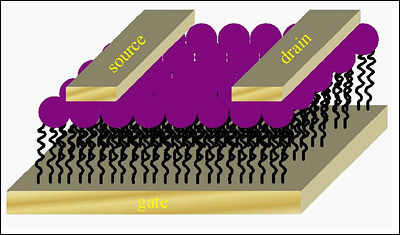Research
Molecular Electronics
“There is plenty of Room at the Bottom” is a well known quote from Nobel laureate Richard P. Feynmann in 1959. It implies that devices, based on molecules, will play an important role in electronic applications in the near future. Such devices could even be based just a few molecules, or maybe even on just one. Therefore, we use the term “nanotechnology” or “molecular electronics”. The central theme in our research group is the design and the synthesis of ‘smart’molecules that can perform special functions in a device. Hence, in our group we do not only synthesize new structures for molecular electronics, but we also make devices and the results are used as input for further improvement of the molecular properties. In short: organic synthesis for and through nanotechnology.
Transistors from self-assembling molecules (Renske Valk)
Our project with self-assembling fullerene derivatives is a good example of trying to use ‘smart’ molecules to make electronic devices. Here, we are planning to mimic the principle of a classical field effect transistor on the molecular length scale. Several fullerene derivatives containing a semiconducting and an electrically insulating ‘layer’ have been designed. (figure 2). The fullerene moiety is the electron conducting part, while the covalently attached alkyl chains serve as the insulating layer. The length of the alkyl chains is varied between ~ 10 and 20 methylene units. The challenge is not only in the synthesis, but mostly in the preparation of close to perfect self-assembled monolayers with these molecules. We hope to find the optimal monolayer formation on a Au(111) surface by varying the length as well as the number of alkyl chains on the fullerene. We are also investigating applications of such monolayers other than for nanoscale transistors (as in OLEDS, for example)

Building blocks for a molecular computer (Hennie Valkenier - van Dijk)
The integration of molecules in electronic circuits has become a real scientific challenge since a number of years. Molecules are the smallest possible building blocks for electronic circuits. Small, smaller, smallest is both to lead to more compact data storage, and to new technological developments. An important element in a ‘molecular computer’ is the way to ‘solder’ the various functional molecules – like logic elements, diodes, transistors - together. Here, we think of coupling two or more (molecular) wires using a molecular ‘intersection’ or a T-piece, like what is done with copper ‘wires’ (channels) on the presently lowest scale of ~ 50-100 nm. In a way it is remarkable that many scientists have come up with proposals for molecular transistors, diodes, or switches, but that nobody has formulated thorough ideas regarding ‘molecular soldering’. This is remarkable because truly molecular computers without molecular interconnections between the active elements are quite unimaginable. Recently, we have developed a new concept for ‘molecular soldering’. We call the principle on which it is based ‘omniconjugation’; the molecules are ‘omniconjugated’.

